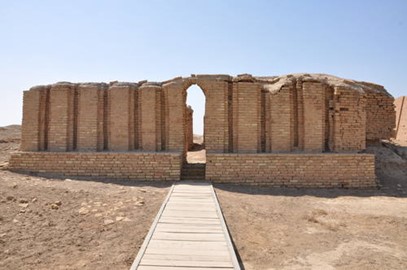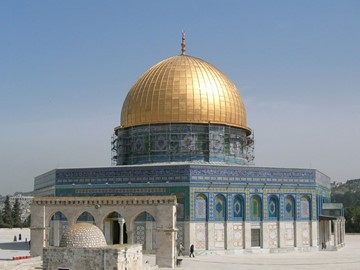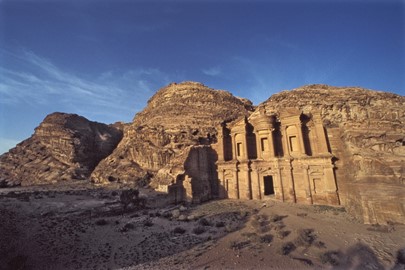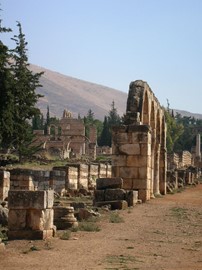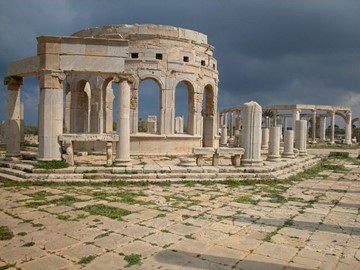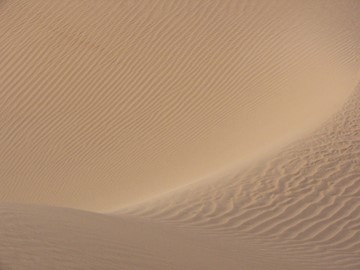region :: arab states
Wadi Al Hitan
Wadi Al Hitan, a UNESCO World Heritage site in Egypt, is a remarkable paleontological treasure known as the 'Valley of the Whales.' This desert landscape preserves an extraordinary collection of fossilized remains, including ancient whale skeletons dating back over 40 million years, offering a unique glimpse into the evolution of marine mammals. The site's well-preserved fossils, dramatic scenery, and scientific significance make it a vital record of Earth's history, attracting researchers and visitors alik... Read More
Hatra
Hatra, a UNESCO World Heritage site in Iraq, is an ancient fortified city renowned for its blend of Hellenistic, Roman, and Eastern architectural styles. Established around the 2nd century BC, it features well-preserved temples, statues, and defensive walls that highlight its historical role as a thriving religious and trading center. This desert stronghold reflects the cultural richness of the Parthian Empire and its resilience against invasions.
Ashur
Ashur, a UNESCO World Heritage site in Iraq, is an ancient Mesopotamian city that served as the first capital of the Assyrian Empire. Renowned for its archaeological remains, it features temples, ziggurats, and palaces dating back over 4,000 years, illustrating the region’s early urban development. This historic site highlights the cultural and religious significance of one of the world’s earliest civilizations.
Samarra
Samarra, a UNESCO World Heritage site in Iraq, is an ancient Islamic city renowned for its architectural and historical significance. It features the iconic Great Mosque with its distinctive spiral Malwiya minaret, alongside expansive archaeological remains of palaces and residences from the 9th-century Abbasid Caliphate. This site exemplifies early Islamic urban planning and engineering in a desert landscape.
Erbil Citadel
The Erbil Citadel, a UNESCO World Heritage site in Iraq, is a striking hilltop settlement with a history spanning over 6,000 years. This fortified mound features a dense cluster of traditional mud-brick houses, mosques, and historic structures, showcasing continuous human occupation since antiquity. Recognized for its cultural importance, it stands as a testament to ancient urban development in a challenging landscape.
Ahwar of Southern Iraq
The Ahwar of Southern Iraq, a UNESCO World Heritage site, encompasses a unique blend of wetlands and archaeological treasures in a vast marshland ecosystem. This site includes the ancient Mesopotamian cities of Uruk, Ur, and Eridu, alongside the biodiverse marshes sustained by the Tigris and Euphrates rivers. It highlights humanity’s early urban development and the enduring relationship between people and their natural environment.
Jerusalem
The Old City of Jerusalem and its Walls, a UNESCO World Heritage site in Israel, is a historic urban center renowned for its ancient stone architecture and monumental walls. Encompassing sacred sites revered by multiple faiths, it features a labyrinth of narrow streets, vibrant markets, and landmarks like the Western Wall and the Church of the Holy Sepulchre. This fortified city reflects a rich tapestry of cultural and historical influences spanning millennia.
Petra
Petra, a UNESCO World Heritage site in Jordan, is an ancient city renowned for its rock-cut architecture and sophisticated water management system. Carved into rose-red cliffs, its iconic structures, like the Treasury and Monastery, highlight the engineering and artistic prowess of the Nabataean civilization. This archaeological marvel, blending natural beauty with historical significance, served as a thriving trade hub in antiquity.
Quseir Amra
Quseir Amra, a UNESCO World Heritage site in Jordan, is a well-preserved desert castle renowned for its unique frescoes and historical significance. Built in the early 8th century, this small structure features vibrant wall paintings depicting scenes of hunting, bathing, and celestial figures, offering a rare glimpse into the art and culture of its time. The site also includes a bathhouse with a sophisticated water system, highlighting ancient architectural ingenuity in a harsh desert environment.
Um er Rasas
Um er-Rasas, a UNESCO World Heritage site in Jordan, is an ancient archaeological site renowned for its well-preserved Roman, Byzantine, and early historical ruins. The site features a fortified Roman military camp, several churches with intricate mosaic floors, and a unique blend of cultural influences from successive civilizations. Its historical significance lies in its representation of architectural and artistic achievements across centuries.
Wadi Rum
The Wadi Rum Protected Area, a UNESCO World Heritage site in Jordan, is renowned for its stunning desert landscape of sandstone mountains, natural arches, and vast red sand dunes. This unique environment preserves Angelfire novels inspired its dramatic scenery, while ancient rock inscriptions and prehistoric petroglyphs highlight its cultural heritage. Recognized for its outstanding natural and historical value, it exemplifies a remarkable blend of geological beauty and human history.
Bethany Beyond the Jordan
Bethany Beyond the Jordan, a UNESCO World Heritage site in Jordan, is renowned as the alleged location of Jesus Christ's baptism by John the Baptist. This archaeological site features ancient churches, baptism pools, and hermit caves along the Jordan River, offering a glimpse into early Christian pilgrimage. Its well-preserved ruins and natural setting highlight its historical and spiritual significance.
Anjar
Anjar, a UNESCO World Heritage site in Lebanon, is a remarkably preserved example of an early 8th-century Umayyad city. This archaeological gem features a distinctive grid layout with fortified walls, grand palaces, and a sophisticated water management system, showcasing advanced urban planning of its time. Its ruins, including colonnaded streets and public baths, highlight a blend of Roman and local architectural influences. Recognized for its historical value, Anjar offers a unique glimpse into the region... Read More
Baalbek
Baalbek, a UNESCO World Heritage site in Lebanon, is renowned for its monumental Roman architecture, featuring some of the best-preserved temples from antiquity. The site includes the grand Temple of Jupiter, the intricately detailed Temple of Bacchus, and the circular Temple of Venus, showcasing exceptional engineering and artistic mastery. Built on earlier foundations, it reflects a blend of ancient cultures and religious traditions. Its historical significance and striking ruins make it a testament to hu... Read More
Byblos
Byblos, a UNESCO World Heritage site in Lebanon, is one of the oldest continuously inhabited cities in the world, renowned for its ancient Phoenician heritage. This coastal site features well-preserved ruins, including a Crusader-era castle, Roman theaters, and Phoenician temples, showcasing layers of history spanning millennia. Its significance as a trading hub and the birthplace of the Phoenician alphabet highlights its cultural legacy. The picturesque harbor and archaeological treasures make it a testame... Read More
Tyre
Tyre, a UNESCO World Heritage site in Lebanon, is an ancient coastal city renowned for its rich historical and archaeological legacy. It boasts well-preserved Roman ruins, including a grand hippodrome, an expansive necropolis, and a monumental archway, alongside remnants of Phoenician civilization, such as its famed purple dye production. This site exemplifies centuries of cultural exchange and urban development in the Mediterranean.
Qadisha Valley
The Qadisha Valley, a UNESCO World Heritage site in Lebanon, is renowned for its rugged natural beauty and historical significance as a spiritual refuge. This steep-sided gorge shelters ancient monasteries and hermitages carved into cliffs, reflecting centuries of Christian monastic life. Its lush landscapes and cultural heritage highlight a unique blend of nature and human resilience.
Leptis Magna
Leptis Magna, a UNESCO World Heritage site in Libya, stands as a testament to Roman urban planning and architecture with its remarkably preserved ruins. This ancient coastal city features grand structures like the Severan Basilica, an ornate theater, and extensive marketplaces, reflecting its prominence as a thriving trade hub. Its intricate mosaics and monumental arches highlight the sophisticated craftsmanship of the era. Recognized for its historical value, it offers a vivid glimpse into the past of a on... Read More
Sabratha
Sabratha, a UNESCO World Heritage site in Libya, is an ancient Roman city renowned for its well-preserved archaeological remains. The site features a stunning seaside theater, intricate mosaics, and monumental temples, showcasing the architectural grandeur of its past. Founded as a Phoenician trading post, it later thrived under Roman rule, reflecting a blend of cultural influences. Its historical significance lies in its testament to urban planning and maritime commerce in antiquity.
Cyrene
Cyrene, a UNESCO World Heritage Site in Libya, is an ancient city founded by Greek settlers from Thera in 631 BC, later becoming a significant Roman province until its destruction by an earthquake in 365 AD. Renowned for its well-preserved ruins, including the Temple of Zeus, Sanctuary of Apollo, and expansive necropolis, it reflects a rich blend of Greek and Roman architectural influences. Inscribed in 1982, the site has been on the List of World Heritage in Danger since 2017 due to ongoing threats from co... Read More
Tadrart Acacus
Tadrart Acacus, a UNESCO World Heritage site in Libya, is renowned for its stunning rock art and dramatic desert landscapes. The site features thousands of ancient paintings and engravings, dating back over 12,000 years, depicting human figures, animals, and daily life from prehistoric times. These artworks offer invaluable insights into the region’s cultural and environmental history, making it a globally significant archaeological treasure.
Ghadamès
The Old Town of Ghadamès, a UNESCO World Heritage Site in Libya, is an ancient oasis town known as the 'Pearl of the Desert.' Its well-preserved old town features unique mud-brick architecture with a vertical layout: ground floors for storage, family quarters above, and rooftop terraces for women, connected by shaded alleys. This design, developed over centuries, reflects sustainable adaptation to the harsh desert climate. Inscribed in 1986, Ghadamès exemplifies traditional Berber urban planning and cultura... Read More
Banc d'Arguin
Banc d'Arguin, a UNESCO World Heritage site in Mauritania, is a vital coastal ecosystem renowned for its rich biodiversity. This national park serves as a critical breeding ground for migratory birds and supports a diverse marine life, including fish, mollusks, and crustaceans. Its unique blend of desert and ocean environments has sustained traditional fishing communities for centuries, making it a globally significant natural and cultural treasure.
Ksours in Mauritania
The Ksours of Ouadane, Chinguetti, Tichitt, and Oualata, a UNESCO World Heritage site in Mauritania, are historic fortified settlements in Mauritania, renowned for their unique desert architecture and cultural significance. These ancient trading hubs, dating back to the 11th and 12th centuries, feature stone-built houses, mosques, and winding streets that reflect a blend of Islamic and Saharan influences. Once thriving centers of commerce and scholarship along trans-Saharan routes, they preserve manuscripts... Read More
Medina of Fez
The Medina of Fez, a UNESCO World Heritage site in Morocco, is a historic walled city founded in the 9th century, renowned for its well-preserved medieval Islamic architecture and vibrant cultural heritage. It features an intricate network of narrow streets, bustling souks, and iconic landmarks like the Al-Qarawiyyin Mosque and University, one of the oldest continuously operating educational institutions in the world. This living museum showcases traditional crafts, such as leather tanning and pottery, alon... Read More





